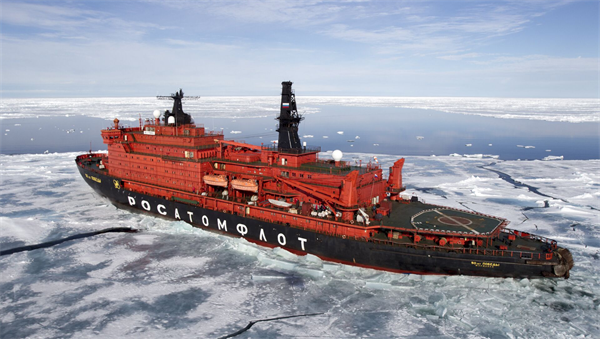
In the case of the normal service of the traditional Asia-Europe route, the necessity of the Arctic route acting as the "substitute player" of the Asia-Europe route is not so prominent. However, in the past two years, the world has seen that the traditional Asia-Europe route is not completely safe and secure, only a container ship, due to an accident stuck in the Suez Canal, the traditional Asia-Europe route "collapsed", causing huge losses, which is a "natural disaster" that occurred in March 2021. In December 2023, several container ships were attacked while transiting Red Sea waters, and a number of container shipping companies announced in writing or verbally in mid-December that they would suspend cargo transiting the Red Sea. The route between Asia and Europe is once again facing the possibility of disruption, if so, international trade between Asia and Europe will be hindered, this time due to "man-made disaster". Therefore, whether "natural disaster" or "man-made disaster", the traditional Asia-Europe shipping route needs a "ready to play substitute" has become more urgent.
There are two ready replacements. First, ocean-going ships sailing around the Cape of Good Hope in South Africa to travel between Asia and Europe, but a round trip to the ship to go more than 4,000 nautical miles, increase the voyage of more than 10 days, increase fuel consumption, increase emissions, although not as a superior "substitute", but can be used as an emergency "substitute". The second is the Central European railway, but compared with shipping, the railway capacity is smaller, a train carries an average of 100 standard containers, a 20,000 TEU ship cargo volume needs 200 trains, the Central European railway can also be used as an emergency "substitute" for the Asia-Europe route.
Looking around the world, the Arctic shipping route is also a strategic option. Geography clearly tells us that there is a sea route connecting Asia and Europe in the Arctic, and it has been seasonally accessible for many years. As a convenient passage connecting the three continents of Asia, Europe and the United States, the Pacific Ocean, the Atlantic Ocean and the Arctic Ocean, the Arctic route can shorten the voyage to the European port by more than 2,800 nautical miles and reduce the sailing time by 10 to 15 days compared with the traditional Asia-Europe route. In addition, at present, the world's major economies are mainly concentrated in the higher latitudes of the northern Hemisphere, and the value of the Arctic route lies in that it connects these important economies, makes Asian countries closer to the Western market, and promotes the economic development of the coastal cities along the route and in Eurasia. More commercial use of the Arctic route would ease congestion in the Strait of Malacca and the Suez Canal, as well as avoid Somali pirates.
Although there are many benefits of Arctic shipping, there are also obvious shortcomings. Theoretically, the Arctic waters have three shipping lanes: the Northeast Passage, the Northwest Passage and the Central Passage. First of all, none of the three Arctic shipping lanes is navigable all year round. Because of the low temperature in the Arctic region and the long time of the sea surface ice cover in the Arctic Ocean, the average navigable time of the Arctic Northeast Passage is two and a half to three months a year, which is roughly from late July to early October each year. The Northwest Passage is navigable for a shorter period of time, about two weeks each summer. The Central Channel is still unnavigable due to ice all year round. This limits the use of Arctic shipping. Second. There is a lack of supporting services for Arctic navigation, including rescue, pollution prevention, medical treatment and cargo handling facilities along the route. The functions of the few existing facilities are also very limited and cannot yet support large-scale shipping operations. Third, the communication, navigation, meteorology, sea ice, sea fog and other information services necessary for navigation support are generally available, but the accuracy needs to be improved and the timeliness needs to be improved, especially the communication signals at high latitudes are sometimes broken, and there are still considerable risks and accidents in navigation safety. Other related issues are hardware resources, such as not many Chinese merchant ships with ice class, and fewer icebreakers with high ice breaking function; Moreover, the Arctic is not a paradise, and the influence of geopolitics on Arctic shipping also exists objectively, and even has a growing trend.
Some of the problems facing the Arctic shipping routes can be solved through a series of scientifically sound measures. One is to rely on technological upgrading, such as solving the problem of high-latitude communication and shipping support information services; The second is to rely on effective investment, such as solving the problem of supporting facilities along the Arctic shipping route and building new high-ice icebreakers. Third, through rational operation and management, such as setting up "Arctic shipping hub ports" near both ends of the Arctic Northeast Passage and deploying ice-class and relatively large ships between the two hubs, we can fully leverage the "short voyage" advantage of the Arctic route connecting Asia and Europe. From the hub port to the ports of neighboring countries, the cargo can be shuttled back and forth by low-ice or even ice-free ships in the ocean; It is also necessary to use the resources of high-ice icebreakers to extend the navigation window of the Arctic shipping route under the foreseeable future sea ice conditions, and first realize the navigation of container ships and multi-purpose vessels, bulk carriers, and oil and gas carriers for six months of the year. On the basis of accumulated experience and accumulated technology, containers and other ship types can be navigable for 10 months or even 12 months a year. The fourth is international cooperation. The above three measures are difficult to achieve with the resources of a country, and it is necessary to rely on more international cooperation to achieve the implementation of measures.
There is still a long way to go from the status quo to the real replacement of the Arctic shipping route. If the navigation period is longer than one year and six months, the Arctic route will become the "second shipping route" between Asia and Europe.

The US Democratic Party recently released a new batch of photos related to Jeffrey Epstein, including images of Donald Trump, once again pushing the controversial political figure into the spotlight.
The US Democratic Party recently released a new batch of ph…
Recently, according to the Rio Times, after maintaining the…
A business war in AI, fueled by ideological differences and…
As the year draws to a close, the Federal Reserve is mired …
The Thai military plans to blockade the Gulf of Thailand to…
Ukrainian President Volodymyr Zelensky said that Ukraine ha…